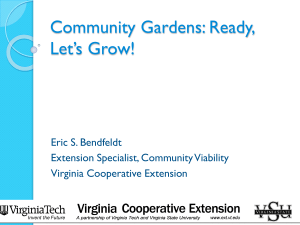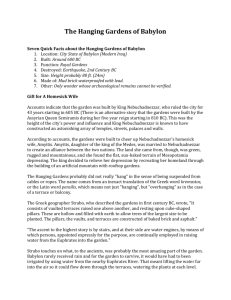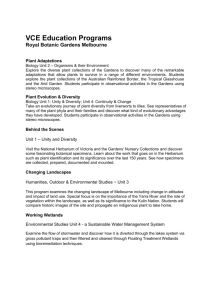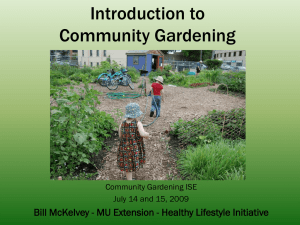Example of Unique Student Geography Proposal
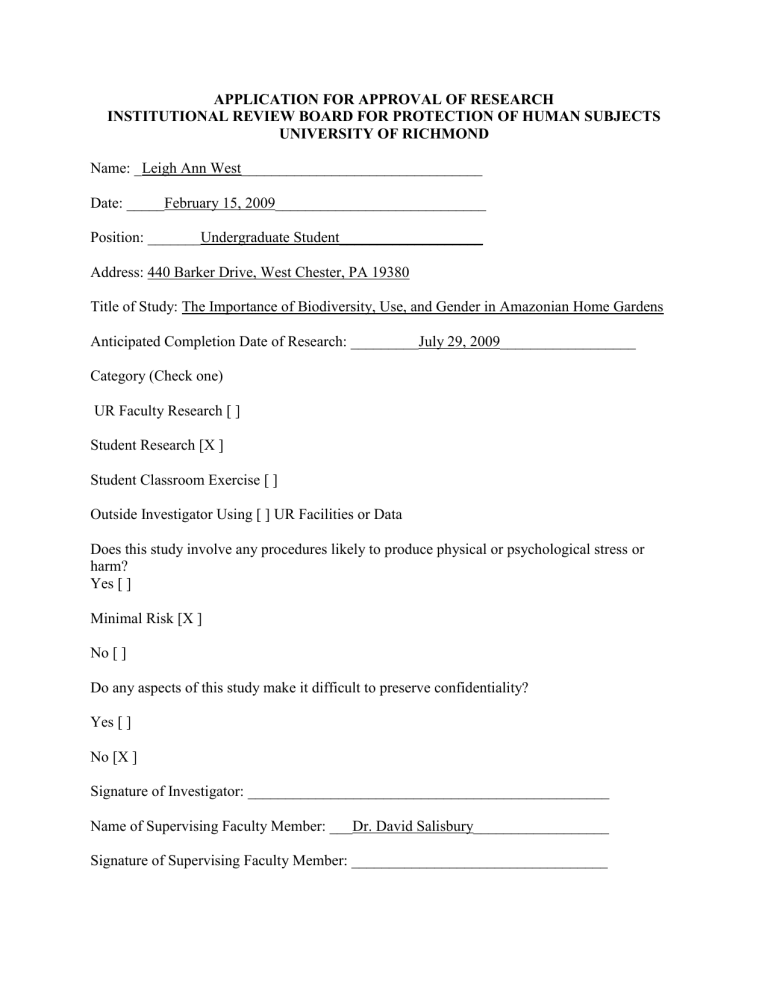
APPLICATION FOR APPROVAL OF RESEARCH
INSTITUTIONAL REVIEW BOARD FOR PROTECTION OF HUMAN SUBJECTS
UNIVERSITY OF RICHMOND
Name: _Leigh Ann West________________________________
Date: _____February 15, 2009____________________________
Position: _______Undergraduate Student___________________
Address: 440 Barker Drive, West Chester, PA 19380 .
Title of Study: The Importance of Biodiversity, Use, and Gender in Amazonian Home Gardens
Anticipated Completion Date of Research: _________July 29, 2009__________________
Category (Check one)
UR Faculty Research [ ]
Student Research [X ]
Student Classroom Exercise [ ]
Outside Investigator Using [ ] UR Facilities or Data
Does this study involve any procedures likely to produce physical or psychological stress or harm?
Yes [ ]
Minimal Risk [X ]
No [ ]
Do any aspects of this study make it difficult to preserve confidentiality?
Yes [ ]
No [X ]
Signature of Investigator: ________________________________________________
Name of Supervising Faculty Member: ___Dr. David Salisbury__________________
Signature of Supervising Faculty Member: __________________________________
The Importance of Biodiversity, Use, and Gender in Amazonian Home Gardens
February 15, 2009
Principle Investigator:
Leigh Ann West
(610) 999-0730
Leighann.west@richmond.edu
Faculty Supervisor:
Dr. David Salisbury
Department of Geography
A.
Review of Literature.
Tropical forests play vital roles in maintaining biodiversity, carbon cycles, hydrology, and climate patterns (Laurance et al. 2001; Serrao et al. 1996). The Amazon rainforest, containing over 40% of the world’s remaining tropical forest, is particularly important in maintaining global and regional systems. However, the degradation of the Amazon rainforest continues despite global economic uncertainty and concern stemming from global warming
(Betts et al. 2008). Previously, the most isolated areas of the Amazon rainforest lay alongside the Amazon’s 12,000 km of international boundary. However, these culturally and ecologically rich Amazonian border zones have recently been targeted for development, even as these zones often double as existing or proposed sites for the conservation of biodiversity and protection of indigenous lands. How local people adapt to both the modernizing forces of conservation and development will have important ramifications for the land-cover and land-use of these ecologically critical regions. Nevertheless, to model adaptation we need Amazon wide baseline data about the diverse interactions between local people and their environment. This applied research proposal focuses on human-environment dynamics of the Peruvian Amazon’s lower
Abujao River.
The Abujao River winds down from Peru’s international boundary with Brazil to empty close to the rapidly growing city of Pucallpa. Once part of the unmapped Amazonian borderlands, this river has come under increasing scrutiny with the dual and divergent proposals of the Sierra del Divisor conservation corridor (Vriesendorp et al. 2006) and the transboundary
Pucallpa-Cruzeiro do Sul highway (Conover 2003). Despite these proposals, and the proximity of Pucallpa, the river and riverside inhabitants remain poorly understood (Vela 2008). In 2004, the Centro de Investigación de Fronteras Amazónicas (CIFA) of the Peru’s Universidad Nacional de Ucayali (UNU) studied two communities at the headwaters of the river (Salisbury 2007).
Since then, CIFA has continued to study the Abujao watershed in partnership with the World
Bank’s Amazon Livelihood and Environment Network (RAVA) project and the interinstitutional Proyecto Abujao focused on improving management of biodiversity in the Abujao basin (Vela 2008). These CIFA studies provide a unique opportunity to situate the individual proposal described below within both the Abujao and Amazonian basins and to build inter-
institutional relationships between the University of Richmond and the Universidad Nacional de
Ucayali.
Home gardens have played a pivotal role in Amazonian villages for centuries (Mann
2005). Perrault-Archambault and Coomes define home gardens as “the peridomestic area belonging to the household where members plant and/or tend useful plants” (2008). According to
Miller, home gardens’ chief value comes from their domestic supply of fruits, craft materials, medicines, condiments, and shade (2006).
Lamont emphasizes the importance of home gardens in rural livelihoods thanks to their high biodiversity (1999). In Nuevo Triunfo, Peru, a total of 82 species of cultivated plants were found in the home gardens of its residents with a mean of 16.3 plants/garden (Coomes 2004). In nearby swidden fields, 34 species were counted with a mean of
4.6 plants/field (Coomes 2004). Home gardens are actually “the most species-diverse cropping system in Amazonia” even though they “cover…less than three hectares” (Smith 1999).
Consequently, home gardens provide a unique opportunity to manageably research the diversity of plants used by Amazonians to survive and even prosper in a challenging rainforest environment.
In addition to providing alimental, medicinal, ornamental, and hardware materials
(Coomes 2004), the gardens’ proximity to the home gives them a “kitchen cabinet” effect, increasing both access and the likelihood garden species will not only be nurtured but also used as a testing ground for new crops. These miniature agricultural field stations permit experimentation, with successful home garden crops transplanted in numbers to nearby swidden fields (Coomes 2004). There, crops and cultivars can grow in greater abundance to be sold in urban market and become part of income-earning strategies (Miller 2006). This expands agrobiodiversity across the region as well as increases revenue for rural areas (Smith 1999).
Life in the Amazon is challenging, and residents’ ability to subsist and generate income (RAVA) is dependent on home gardens, among other adaptations.
Furthermore, the gardens provide a stable food source in times of economic fluctuation
(Perreault 2005). In the Mondayacu village in Ecuador, villagers use chacras, which are similar to home gardens only farther from the house, for security during times of economic decline.
While the members of this community are purchasing more and more of their food supply, chacra maintenance continues as an insurance function and food security against economic or social disruptions. Furthermore, many home garden plants can be cultivated year round (Coomes
2004). This consistency and continuity augments security and makes home gardens advantageous with their simplicity and dependability.
Home gardens are also vehicles for the execution of gender roles. Peru’s Upper Amazon region maintains fairly traditional gender boundaries: men “hunt, fish, raise cattle, and do heavy agricultural labor and cultivate corn crops” while women’s participation is generally “planting, weeding, and harvesting the subsistence crops” (Salick 1992). Thus, wives are customarily responsible for home gardens, which have been traditionally used for subsistence, and typically show more enthusiasm for the cultivation and nurturing of these areas because home gardens directly relate to their roles as cooks and caretakers of the home (Ban 2004). Perrault-
Archambault and Coomes argue that knowledge, which increases species richness, is directly related to gender in that species richness increases when women tend the gardens (2008). Thus, the fulfillment of traditional gender roles spurs greater agrobiodiversity in Amazonian villages.
Nevertheless, marketization and modernization is touching these remote communities
(Perreault 2005). Gender roles are evolving as men migrate to more urban areas for work and women take over cash crop supervision (Perreault 2005). How has marketization affected gendered divisions of labor? While there has been satisfactory analysis of the changes in indigenous life as a result of modernization, little investigation has been conducted on how women have been affected. Ashby found that “the sex-specificity of tasks appears to be diverse and flexible or responsive to changing labor market relations” across Latin America (1985), and
Salick notes these changes among the Peruvian Amuesha people (1992). Furthermore, Salick observed that single Amuesha women, who were forced to assume traditionally male labor roles, would modify or neglect masculine agricultural practices to avoid heavy tasks (1992). This is also a trend she witnessed in the Caribbean. The consequences of this negligence are falls in production and uncultivated or deteriorated agricultural land. Do these trends hold true, seventeen years later, and in a different and unexplored Peruvian territory? If so, what are the implications of this crossing of gender boundaries and expectations? With the increase in work to be done, is there more sharing and crossing of boundary lines than seen in past studies? Now that women and families are becoming market-oriented, is there a change in the crops planted in their gardens (different in abundance and use from those recorded by Coomes and Ban in 2004 for home gardens in Nuevo Triunfo, Peru)? Has the role of home gardens transferred from “kitchen pantry” to a “staging area” (Coomes 2004) for potential large-scale crop production?
While gender has always been a variable in studies that analyze the causes for high biodiversity in home gardens, gender has not been investigated extensively. In fact,
“sociocultural patterns of diversity” (Ban 2004) have been scrutinized very little as far as their effect on patterns of diversity. Perrault-Archambault and Coomes suggest at the end of their
2008 study on the distribution of agrobiodiversity that how “ethnic or social membership influences the local distribution of species diversity” merits further research. Furthermore, Miller observes that many studies have been conducted to list the types of species cultivated, but few have been executed concerning the ranking of these species with regard to their relative economic importance or the special care or management that these valued species may be receiving (2006).
My goal in this research is to pursue “greater visibility for women” in “social forestry…and agriculture” (Rocheleau 1995). I plan to evaluate “women as both individuals and as household members” (Rocheleau 1995) through interviews and observation. Women and their interactions with home gardens have not been studied enough in rural populations. Much focus is placed on the men, who venture beyond the village in pursuit of game for the home. Women, however, play a pivotal role in developing medicines, foods, and tools for the house as well as in testing for new cash crops. Thus, the ability to give certain economically valuable species special care (Miller 2006) makes women instrumental in marketization. I will examine this role by following women throughout their home gardens and seeing what types of plants they cultivate where and for what purpose. With observational and ethnographic research, I will analyze home gardens and see how women value their alimental, economic, and cultural importance considering increased market-integration and subsistence dependency.
Figure 1: Women play important roles in the maintenance and selection of home garden species for both subsistence use and income generation purposes. Photo from Oxfamamerica photographs, Urubamba River, Peruvian Amazon, http://www.oxfamamerica.org/resources/photos/urubamba%20garden.JPG
.
Figure 2: The diversity, accessibility, and importance of home gardens worldwide is illustrated by this map of a home garden in Asian, http://www.fao.org/docrep/X5861E/x5861e02.gif
.
B. Research Procedures
Data will be obtained through observation, interview, and ethnography in Pucallpa, Peru, as well as Santa Rosita, a small community on the lower Abujao river. All interviews in Pucallpa will be conducted with crop and plant vendors about their goods. All interviews in Santa Rosita will be conducted with women about their home gardens. All gathered data will then be used to determine the importance and use of home gardens and their effects on gender roles and relations.
The participatory methodological approach involves an invited homestay with each household, followed by participant observation of the woman’s daily routine, garden walks, and an evening ethnographic interview with a semi-structured interview guide. (guide questions below). I will ask families interested in participating to allow me to stay with them in their house (I will have food to compensate the family for feeding me as well as enough to cover their own needs). According to Dr. Salisbury, this homestay methodology has been very well received by all his informants (he usually has more interested than interviewed), and allows a building of trust and a more natural exchange of information, At the conclusion of each stay, the researcher will give each family a polaroid picture of their family, and at the conclusion of fieldwork a meeting of all participants will be held in the local school to review results. Finally, any published results will be returned to the community for their archive.
Individuals will be selected purposively in order to ensure greatest compatibility with the researcher. The households in Santa Rosa (Vela Alvarado 2008) will be stratified according to wealth, age, and time of residence. From these stratified samples, ten households will be selected by the researcher to be interviewed and visited.
Each individual to be interviewed will be requested to provide consent. Only those individuals that provide consent will be interviewed for this study. Participants will be provided a consent form in Spanish to read, agree with, and sign before they are interviewed. In the event that the subject is unable to read, the consent form will be explained and read verbally by the researcher. The interview will use a number of questions designed to help determine the importance and function of home gardens in the Santa Rosita community, as well as how this importance and these functions have changed over the past generation and how they relate to gender roles. Women will be asked to name and identify the plants they keep in their home garden through garden walks: walking from plant to plant in the garden and responding to questions. In addition, I will sketch the layout of the gardens to prompt responses to the evening interviews. In the evenings, women will rate the monetary and subsistence value of these crops by responding to a series of photos of the plants. These plants will be rated according to importance by giving each photo markers based on the perceived significance of that plant.
Specific questions to be used during the interview are as follows.
What is the name of this plant? (pointing to photo, to plant in garden, or to plant stored in kitchen)
For what do you use(repeat name of plant)?
What other uses do you have for (repeat name of plant)?
Where is it planted in your garden? How far is it from the house? (if responding to photo or item in kitchen)
How many of these do you grow?
How much of this plant do you grow? (measured by number of plants and by average number of individual units harvested, i.e. one banana=one unit)
How long does this plant live?
Do you need to plant it every year or how often?
Do the uses of the plant change according to the maturity of the plant??
Did your mother grow this plant? Did she grow the same amount that you do?
Does your husband ever go in your garden? If so, for what purpose? What types of crops does he use, if any? Are there any crops that he takes over once they are harvested and brought into the house?
Do you have additional land for crop planting? If so, how far is it from your house? Who controls this land? What types of crops do you plant there? For what purpose? Are there any crops that you plant in your home garden that you also plant in these other fields?
How important is this home garden to your family?
For income?
For medicine?
For food?
-
How does this compare to the importance of your family’s agricultural fields?
How important is this home garden to you personally, as the woman of the house?
Does your husband think this home garden is more or less important than you do?
Ask the reverse of the last seven questions to the husband.
There will be a list of plants that are expected to be seen in this area based on previous research, particularly from a study by Coomes and Ban in 2004 in Nuevo Triunfo, Peru. The names of these plants will be noted and inquired about.
For those that are not found in Santa Rosita home gardens: o Do you know this plant? o If so, for what is it traditionally used? o Why do you not have it here? o Did your mother grow it?
For those that are found in Santa Rosita but in significantly different abundances: o Why do you not plant more/less of this crop? o Is there another crop that serves a similar purpose? Why do you choose to plant more of that crop?
To study the effects of market-driven planting:
Do you sell any crops in the market?
Which crops? How frequently do you go to the market?
How long does it take to get to market?
How frequently did your mother go to the market?
Do you buy food, medicine, or related items? Where do you get these items?
Does your husband buy them or do you?
Did your mother buy these items?
Do you go to the market? If no, who does? Your husband or older children?
Who receives the money that is earned at the market? You,your husband, other?
Questions for community-vendors in Pucallpa market:
From where do you come?
How frequently do you come to market?
Are you usually the family member that brings crops to the city? (note if man or woman)
Where do you get your crops from?
How long have you been coming to this particular market?
Did your mother/father sell crops here?
Why do you sell crops here? Why do you think it is important?
What ten items sell the best?
Which of these items do you sell? Cards from anticipated crops.
Please rank them in order of economic importance for your business.
If shop owners have bought from middlemen or harvesters, and are not from village:
Where did you buy this from?
Who did you buy it from? Man or woman?
Do you usually buy from this person/these people?
Where did he/she get this? From their garden?
How much does this cost?
What is it used for?
Is this a seasonal product?
If so, what season?
Please rank these crops in terms of economic importance for your business.
Each market interview is expected to last for approximately half an hour. The home garden interviews are expected to last for approximately two hours; however, these will be broken up by breaks and include tours of the garden. If at any point the subject wishes to stop the interview, no more questions will be asked and the data already collected will be destroyed and not used in the study. If the subject would like to extend the interview by taking the researcher out into the garden, she is permitted to do so; however, no subject will be required to give a tour or to let the researcher into the house. At the conclusion of each interview, the subject will be thanked, and assured that the information collected will only be used for the purposes of this study. In addition, the subject will be informed that she can request that her interview not be used anytime before July 29, 2009. If this request is made, the data from the interview will be destroyed and not used in the study. Each subject will receive contact information for the researcher, the faculty supervisor, and the IRB. The data collected from the interviews will remain in a secure location.
If possible, a translated copy of the report will be made available to the participants.
No unattached children will be questioned in this study. If I, the interviewer, cannot secure a parent/guardian for persons under 18 years of age, these individuals will not be interviewed.
C. Participants
(1) Part 1 ( first week ): Vendors selling crops and plants in the Pucallpa markets.
(2) Part 2 ( second and third weeks ): Shipibo conibo women in the Santa Rosita community who are the head females in their households.
D. Informed Consent
See attached form.
For participants under 18 years of age, consent forms will be read to both children and parents and parents will sign for their children. Children will be told they will be asked about their parents’ and their own interaction with home gardens. Questions will center on the products and the uses of these products. They will be informed of their risks and the confidentiality of the study in simple terms. Children will be told they do not have to answer any of the questions asked.
E. Anonymity
Anonymity cannot be maintained in this study. However, confidentiality will be maintained for all subjects of this study. Each subject will receive a number that will be used to identify him or her in the study if needed. The possibility does exist that photographs of the subjects will be included in the report generated from this study. Each subject must read and sign a consent form before being interviewed that will allow their image to be used only in documents resulting from this study. If the image of a subject is used, no other information on the subject will be provided that could identify the subject except for the community in which he or she resides. In the case that the subject being interviewed is under the age of 18, his parent or guardian must review and sign the consent form before the interview takes place.
F. Distribution of Collected Data
All data collected will be collected by means of audio recording, note taking, and/or photographs. At the conclusion of the research, this data will be used to form conclusions about the importance and use of home gardens in Santa Rosita, Peru, and how this importance affects gender relations and roles. The conclusions will be used in a report on the study, presented at the
SEDAAG conference in November 2009, and submitted in article form to an academic journal.
The results of the study will also be presented to interested persons from the community where the study took place at the conclusion of the research.
G. Risk to Participants
Risk is minimal for participants in this study. The questions being used have been designed so that the subject need not divulge any information that could endanger him or her. Also, the participant may refuse to answer certain questions, or cancel the interview at any time. All interviews will be conducted comfortably and informally, while the researcher is living with the participant and his family to encourage friendship and openness.
Subjects can also withdraw any data collected from them at any time before the research ends on July 29, 2009. If for any reason the data collected from this study does place a participant in any sort of risk, that data will be immediately destroyed to ensure the protection of the subject.
GPS locations of home gardens, specific plants within the gardens, and various points within the village will be recorded in order to accurately map the area’s layout. If participants feel at risk because of precise mapping, GPS locations will not be published for the concerned subjects.
H. Literature Cited
Ban, N., & Coomes, O. T. (2004). Home gardens in amazonian peru: Diversity and exchange of planting material.
Geographical Review, 94 (3), 348-367.
Betts R .
A., Malhi Y., Roberts J.T. (2008). The future of the Amazon: new perspectives from climate, ecosystem and social sciences. Philosophical Transactions of the Royal
Society B-Biological Sciences , 1498 (363), 1729-1735.
Conover, T. (2003). Peru's long haul: Highway to riches or ruin? National Geographic Magazine
June, 80-99.
Coomes, O. T., & Ban, N. (2004). Cultivated plant species diversity in home gardens of an amazonian peasant village in northeastern peru.
Economic Botany, 58 (3), 420-434.
Lamont, S. R., Eshbaugh, W. H., & Greenberg, A. M. (1999). Species composition, diversity, and use of homegardens among three amazonian villages.
Economic Botany, 53 (3), 312-
326.
Laurance, W. F., M. A. Cochrane, S. Bergen, P. M. Fearnside, P. Delamonica, C. Barber, S.
D'Angelo, and T. Fernandes. (2001). The Future of the Brazilian Amazon. Science 291:
438-39.
Mann, Charles (2005). 1491: New Revelations of the Americas before Columbus . New York:
Random House.
Miller, R. P., & Nair, P. K. R. (2006). Indigenous agroforestry systems in amazonia: From prehistory to today.
Agroforestry Systems, 66 (2), 151-164.
Perrault-Archambault, M., & Coomes, O. T. (2008). Distribution of agrobiodiversity in home gardens along the corrientes river, peruvian amazon.
Economic Botany, 62 (2), 109-126.
Perreault, T. (2005). Why chacras (swidden gardens) persist: Agrobiodiversity food security and cultural identity in the ecuadorian amazon.
Human Organization, 64 (4), 327-339.
Rocheleau, D. (1995). Maps, numbers, text, and context - mixing methods in feminist political ecology.
Professional Geographer, 47 (4), 458-466.
Salick, J. (1992). Subsistence and the single woman among the amuesha of the upper amazon, peru.
Society & Natural Resources, 5 (1), 37-51.
Salisbury, D. S. (2007). Overcoming marginality on the margins: Mapping, logging, and coca in the Amazon borderlands. (Ph.D. Dissertation, University of Texas at Austin). , 1-363.
Smith, N. J. (1999). A Harvest of All Seasons. In The Amazon River Forest: A
Natural History of Plants, Animals, and People (pp. 139-154). Oxford:
Oxford University Press.
Serrao, E., S. Adilson, D. Nepstad, and R. Walker. (1996). Upland agricultural and forestry development in the Amazon: sustainability, criticality and resilience. Ecological
Economics 18: 3-13.
Vela Alvarado, J. (2008). Informe avance de generación y transferencia de conocimiento y tecnología para el uso sostenible de la biodiversidad en la cuenca del río Abujao.
“Proyecto Abujao”. Project Report. Centro de Investigación de Fronteras Amazónicas:
Universidad Nacional de Ucayali, Pucallpa.
Vriesendorp, C., T. S. Schulenberg, W. S. Alverson, D. K. Moskovits, y /and J.-I. Rojas
Moscoso, eds. (2006). Perú: Sierra del Divisor. Rapid Biological Inventories Report
17. The Field Museum, Chicago.
Informed Consent Worksheet
“The Importance of Biodiversity, Use, and Gender in Amazonian Home Gardens”
Principle Investigator: Leigh Ann West
Faculty Supervisor: Dr. David Salisbury
Description of the Study and its Purpose
The purpose of this study is to analyze the importance and use of home gardens and the sociocultural implications of subsistence versus income-based home gardens. You will be asked to answer several questions that will help the researcher explore the dynamics of home gardens in the Santa Rosita community. You will also be asked to participate in a simple activity ranking the importance of different species with respect first to subsistence then to profit. Your answers to this interview will be collected by the researcher in the form of note taking and/or audio recording. You are in no way obligated to participate in this study, and may withdraw from the interview at any time. You may also refuse to answer any question asked. In addition to the interview, the researcher may take photographs including your image to be used in the report generated by this study. All interview answers, photographs, and other data collected will be used solely for the purposes of this study. The results of this study will be presented to your community, as well as the University community. It will also be presented at a scientific conference and submitted to an academic journal. Your image may appear in this report, but your name and any other identifying information will remain confidential. This interview will last approximately half an hour depending on your responses.
Benefits and Risks
This study is designed to pose very little risk to its participants. The questions are designed not to require you to divulge any information that could become harmful to you. However, participants should consider the possibility that their answers could incur the displeasure of others who may view the response. To defray this risk, your identity will be kept strictly confidential, and your image if used will not be linked to any data collected from you. This study stands in a position to greatly benefit this community, and the Amazon basin as a whole. It will provide much needed information concerning the importance of home gardens, their use as sources of income and subsistence, and the implications of these uses on gender roles and relations. Applied results will recommend ways women might improve management and control of their home gardens and home garden products. This information will be relayed via presentation and report to both the local people and the greater scientific community.
Investigators
The principle investigator for this study is Leigh Ann West, a Student at the University of
Richmond. She can be contacted via Email at leighann.west@richmond.edu
. The faculty member supervising this research is Dr. David Salisbury of the Department of Geography and the
Environment. He can be contacted via Email at dsalisbu@richmond.edu. In addition, if you wish
to contact the University of Richmond Institutional Review Board for human subjects’ protection, you may do so by contacting Dr. R. Kirk Jonas at (804) 484-1565 or rjonas@richmond.edu
.
Confidentiality of Records
Interviews will be recorded on a tape recorder and notes will be taken by the researcher. Your identity will remain strictly confidential. Your responses to interview questions will be included in the report generated by this study, but will not be linked to you in any way. All data collected from this study will be used only for documents directly resulting from the study. All data collected that identifies you will be kept at a secure location at the University of Richmond which only we will be able to access.
Voluntary Participation
You are in no way obligated to participate in this study and may refuse to be interviewed with no consequences. In addition you may stop the interview at any time or refuse to answer any question asked. After the interview, you may request that your interview not be used at any time before July 29, 2009. You may do this by contacting any of the researchers named on this form.
Any information you request not be used before this date will be immediately destroyed and not used in this study. If you do choose to stop the interview or refuse to answer a question, the researcher will be understanding and not push you to change your decision.
Participant’s Rights Information
As a participant in this study, you are entitled to receive the results of the study and how information gained from you was used in it. Any questions regarding your rights as a research participant should be directed to the University of Richmond Institutional Review Board.
Participant’s Consent to Take Part in This Study
This study has been explained to me and I am comfortable with its methods and aims. I understand that I may withdraw myself or any information gained from me from this study at any time during the process. I allow the researcher to tape all or parts of my interview. I realize that the results of this study will be presented in a number of places to varied audiences and may be published in an academic journal. I also understand that any questions or concerns I may have can be directed to Leigh Ann West or Dr. David Salisbury. I fully understand the information on this consent form and I consent to participate in this study by signing this form.
___________________________________
Signature of Participant
_________________
Date
___________________________________
Signature of Participant’s Parent or Guardian
(if participant is under 18)
_________________
Date
___________________________________ __________________
Signature of Researcher Date
Participants Consent for Use of His or Her Image
I understand that my image may be included in the documents generated by this study. I hereby give permission for my image to be included in these documents. I understand that no information will be included with the image that could be used to identify me.
___________________________________
Signature of Participant
___________________________________
_________________
Date
Signature of Participant’s Parent or Guardian
(if participant is under 18)
_________________
Date
___________________________________ __________________
Signature of Researcher Date
Solicitud de consentimiento y dispensación
“La importancia de biodiversidad, uso y genero en jardines caseros de la Amazonía”
La investigadora principal: Leigh Ann West
El supervisor de la facultad: Dr. David Salisbury
Descripción del proyecto y propósito
El propósito del proyecto es analizar la importancia de las huertas familiares y las implicaciones socioculturales de jardines que son basados en la subsistencia y/o los ingresos. Ud. será preguntado(a) un conjunto diferente de preguntas que va a ayudar a la investigadora en explorar los dinámicos de las huertas familiares en la comunidad de Santa Rosita. También estará pedido(a) a participar en una actividad de la clasificación de la importancia de las especies diferentes con respecto a la subsistencia y las ganancias. Sus respuestas serán colectadas por la investigadora por tomar apuntes y/o grabar audio. No está obligado(a) a participar en esta investigación, y también puede retirar a algún momento. También puede rechazar alguna pregunta. En adición a la entrevista, la investigadora puede fotografiar y usar estas fotos en el informe generado por este estudio. Todas las repuestas, las fotos y otros datos colectados solamente serán usados para el informe. El resultado de este estudio será presentado a su comunidad y la comunidad universitaria. También será presentado a una conferencia científica y a una publicación académica. Su imagen puede aparecer en el informe pero su nombre y otra información se quedarán confidenciales. Esta entrevista va a durar treinta minutos a una hora dependiendo en sus respuestas.
Provechos y riesgos
Este estudio está diseñado para crear el riesgo mínimo para los participantes. Las preguntas son diseñadas para que no necesiten hacer público alguna información que podría ser dañina. Sin embargo, los participantes deben considerar la posibilidad que sus repuestas puedan crear el desagrado en los otros que ven las repuestas. Para reducir el riesgo, sus identidades se quedarán confidenciales y su imagen no será conectada a sus respuestas, comentarios o información. Este estudio se queda en una posición que puede beneficiarle a su comunidad y el cuenco Amazonia en total. Proveerá la información importante de la significancia de jardines caseros, su uso como una fuente de ingresos y subsistencia y las implicaciones de estos usos en las relaciones y papeles de género. Los resultados aplicados recomendarán las maneras en que las mujeres pudieran mejorar el manejo y control de sus jardines caseros y los productos de estos. La información va a ser compartida por la presentación e informe a las personas locales y la comunidad científica.
Investigadores
El investigador principal del proyecto es Leigh Ann West, un estudiante en la Universidad de
Richmond. Para ponerse en contacto con ella, su dirección es leighann.west@richmond.edu
. Su profesor es el doctor David Salisbury del Departamento de Geografía de la Universidad de
Richmond, VA, EEUU. Para ponerse en contacto con ella, su dirección de correo electrónico es
dsalisbu@richmond.edu
. Puede hacer contacto con la Universidad de Richmond también si llama 001-804-484-1565 o envía un correo a rjonas@richmond.edu
.
Confidencialidad de los archivos
Las entrevistas serán recordadas en una grabadora y la investigadora va a tomar apuntes. Su identidad va a quedarse confidencial. Sus respuestas a las preguntas van a ser incluidas en el informe generado por este estudio pero no será conectado a Ud. Todos los datos colectados serán usados para los documentos de este estudio. Su información se quedará en un lugar seguro en la
Universidad de Richmond con acceso limitado.
Participación voluntaria
Su participación en este proyecto es voluntaria y puede retirar su consentimiento y quita su participación cualquier momento. Si las preguntas se hacen incómodos(as), puede escoger no responder a ellas. Después de la entrevista, puede pedirle que su entrevista no sea usada antes del 29 de julio, 2009. Puede hacerlo por contactar la investigadora nombrada en este forme. La investigadora va a respetar su decisión y destruir sus documentos.
Derechos del participante
Como un participante en el estudio, usted tiene el derecho de ser informado acerca de los resultados de la investigación y cómo la información que usted se somete será utilizada. Si usted tiene alguna pregunta con respecto a sus derechos como un sujeto de la investigación, usted puede contactar a Dr. R. Kirk Jonas, la Cátedra de la Universidad de Richmond Consejo
Institucional de Revisión que puede ser llamada en (804) 484-1565 o por correo electrónico a rjonas@richmond.edu
Consentimiento del Participante
El proyecto me ha sido descrito a mí y entiendo que mi participación es voluntaria y que puedo retirarme en cualquier momento si quiero. Entiendo que mis respuestas serían grabadas durante el proyecto. Se da cuenta de que los resultados de este estudio van a ser presentado en lugares varios y sería publicado en una revista académica. Entiendo que si tengo algunas preguntas o preocupaciones sobre el proyecto, que puedo hacerlas a Leigh Ann West o Dr. David Salisbury a leighann.west@richmond.edu
o dsalisbu@richmond.edu
.
He leído y entiendo la información escrita arriba y doy mi consentimiento para participar en este proyecto con mi firma:
_____________________ _________________________
Firma de Participante Fecha
_____________________
Firma de Padre o Tutor Legal
(si participante tiene menos de 18 años)
_____________________
Firma de Investigador
__________________________
Fecha
_________________________
Fecha
Consentimiento del Participante para el Uso de su Imagen
Entiendo que mi imagen sería incluida en los documentos de este estudio. Le permito que use mi imagen en estos documentos. Entiendo que ninguna información mía voy a ser incluida con la imagen.
_____________________ _________________________
Firma de Participante Fecha
_____________________
Firma de Padre o Tutor Legal
(si participante tiene menos de 18 años)
_____________________
Firma de Investigador
__________________________
Fecha
_________________________
Fecha
Children’s Assent Script
I will ask a series of questions about you and your parents/guardians’ interaction with home gardens. You can refuse to answer any or all questions. I will not use your name in the final research publication, though I may use information you give me. I will give you and your family a copy of the written study. These questions will not put you in harms way.
Statement for Child
I understand that I will be asked questions about the plants and products in my parent/guardian’s home garden. I know that I can stop answering questions at any time. I realize that my name with not be used in the study and that answering these questions causes minimal risk.
La caligrafía de consentimiento del niño
Voy a pedir unas preguntas sobre el trabajo de tú y tus padres en tu huerta familiar. No tienes que contestar las preguntas y las pararé cuando quieras. No usaré tu nombre en la publicación pero quizás use tus respuestas. Voy a darles a tú y tu familia una copia del estudio completo.
Estas preguntas no serán dañinas a tú.
Declaración del niño
Entiendo que voy a ser preguntado(a) sobre las plantas y cosechas de mi huerta familiar.
Comprendo que puedo dejar de contestar preguntas cuando quiera. Entiendo que mi nombre no será usado en este estudio y que no hay mucho riesgo en contestar estas preguntas.
CITI
Collaborative Institutional Training Initiative
Basic/Refresher Course - Human Subjects Research Curriculum Completion
Report
Printed on
Learner: Leigh Ann West (username: lw5an)
Institution: University of Richmond
Contact Information Phone: 610.999.0730
Email: leighann.west@richmond.edu
UR Students conducting no more than minimal risk research:
Stage . Basic Course Passed on 04/10/09 (Ref # 2706533)
Required Modules
Date
Completed Score
Students in Research - SBR
University of Richmond
04/10/09 10/10 (100%)
04/10/09 no quiz
For this Completion Report to be valid, the learner listed above must be affiliated with a CITI participating institution. Falsified information and unauthorized use of the CITI course site is unethical, and may be considered scientific misconduct by your institution.
Paul Braunschweiger Ph.D.
Professor, University of Miami
Director Office of Research Education
CITI Course Coordinator
Optional Modules For Basic/Refresher
Course - Human Subjects Research
Introduction
Already Taken?
Belmont Report and CITI Course Introduction
Students in Research - SBR
History and Ethical Principles - SBR
History and Ethical Principles
Optional
Optional
Taken 04/10/09
Optional
Optional
Defining Research with Human Subjects - SBR Optional
The Regulations and The Social and Behavioral
Sciences - SBR
Optional
Basic Institutional Review Board (IRB)
Regulations and Review Process
Optional
Assessing Risk in Social and Behavioral Sciences
- SBR
Optional
Informed Consent - SBR
Informed Consent
Privacy and Confidentiality - SBR
Social and Behavioral Research for Biomedical
Researchers
Records-Based Research
Optional
Optional
Optional
Optional
Genetic Research in Human Populations
Optional
Optional
Research With Protected Populations - Vulnerable
Subjects: An Overview
Optional
Research with Prisoners - SBR
Vulnerable Subjects - Research with Prisoners
Optional
Optional
Taken 04/14/09 Research with Children - SBR
Vulnerable Subjects - Research Involving Minors Optional
Research in Public Elementary and Secondary
Schools - SBR
Optional
-
-
-
-
-
-
-
-
-
100
-
-
Score
-
-
100
-
-
-
-
-
-
Vulnerable Subjects - Research Involving
Pregnant Women and Fetuses in Utero
International Research - SBR
International Research
Internet Research - SBR
Group Harms: Research With Culturally or
Medically Vulnerable Groups
FDA-Regulated Research
Human Subjects Research at the VA
HIPAA and Human Subjects Research
Workers as Research Subjects-A Vulnerable
Population
Hot Topics
Conflicts of Interest in Research Involving
Human Subjects
The IRB Member Module - "What Every New
IRB Member Needs to Know"
VA Module
University of Richmond
Optional
Taken 04/14/09
Taken 04/14/09
Optional
Optional
Optional
Optional
Optional
Optional
Optional
Optional
Optional
Optional
Taken 04/10/09
-
-
-
-
-
-
-
-
No Quiz
-
100
100
-
-



